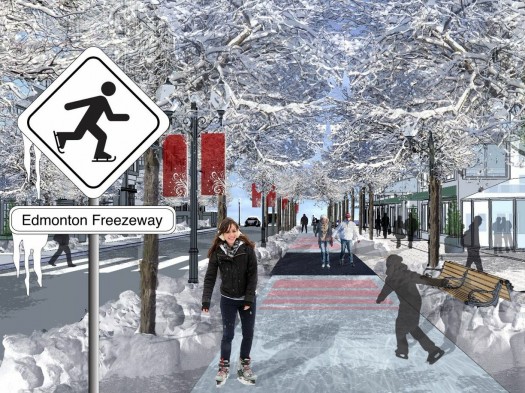A Placemaking Journal
Walkable Winter Cities
 Coming in from my slow run on this morning’s packed snow, I am grateful again for my old, walkable neighbourhood that tempts me out of doors, even in the cold weather. And that’s saying a lot, since I live in Winnipeg, Manitoba, one of the three coldest cities on earth of a population of 600,000 or higher.
Coming in from my slow run on this morning’s packed snow, I am grateful again for my old, walkable neighbourhood that tempts me out of doors, even in the cold weather. And that’s saying a lot, since I live in Winnipeg, Manitoba, one of the three coldest cities on earth of a population of 600,000 or higher.
Walkability mitigates the most extreme climates by providing interesting places to warm up, linger, and connect. And plenty of options about how and where to turn around and circle back.
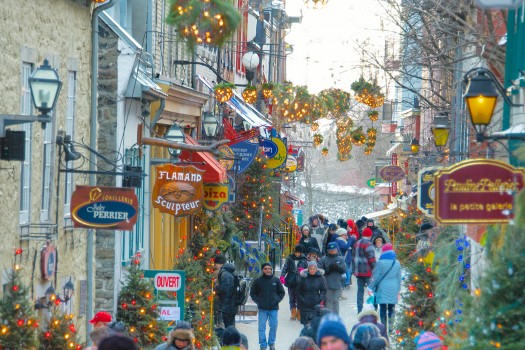
Carnival de Québec, Québec City, Québec. CreativeCommons ShareAlike License with Attribution: flickr user Jamie McCaffrey. Click for larger image.
Regional draws celebrate winter cities. Northern cities tend to go after big winter ideas to compete with the Sun Belt. These major amenities are essential to get us outdoors and moving in the northern winters, and are spectacular and fun, including Ottawa’s Rideau Canal skating trails, Winnipeg’s Assiniboine and Red River trails and warming huts, Carnaval de Québec, Fête des Neiges de Montréal, Winnipeg’s Festival du Voyageur, Lumière de Montréal, and Ottawa’s Winterlude, to name a few. These festivities are generally set in the city center and are regional draws.
However, the greatest parts of each of these walkable winter cities aren’t the headliners, but rather the openers. Those walkable neighborhoods that draw people out to just walk a block or two, and then once you’re geared up, you’re more likely to brave the elements. If we really want to follow the Surgeon General’s warning to step it up, walkability is achieved at the scale of the neighborhood, not the scale of the region.
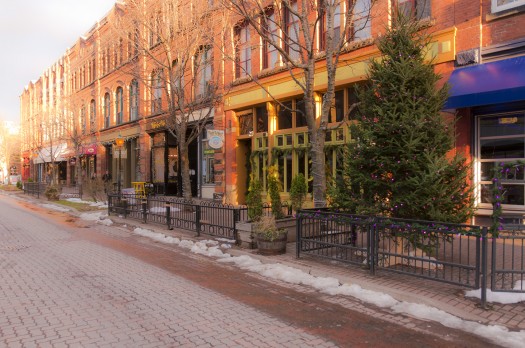
Charlottetown, Prince Edward Island. Copyright: Steve Mouzon. Click for larger image.
The useful walk is the first thing that makes us willing to step outside. Having our daily needs available within a 5-minute walk makes it faster just to walk there instead of finding a place to park on the snowy streets. Homes near schools, offices, shops, restaurants, parks, and places of worship make active transportation something more than a new year’s resolution. The 5-minute walk is the radius that defines the neighbourhood circle.
Our weekly needs are a different story. While I’ll jump on my bike during temperate seasons to attend a meeting downtown – three neighborhoods away – I’m somewhat risk-averse to cycling in winter and the 25-minute walk at -20 C usually will prompt me into a bus or cab. When I do walk downtown in the winter, I’m always happy for the plentiful coffee shops for warm-ups.
Outdoor rooms are created by a sense of enclosure, perhaps the most critical element of placemaking. Standard suburban enclosure is a 1:6 ratio of building height to street width. Shallow setbacks and skinny streets help us get to 1:2 or 1:3 ratios on main streets, and street trees help deliver enclosure for less urban conditions.
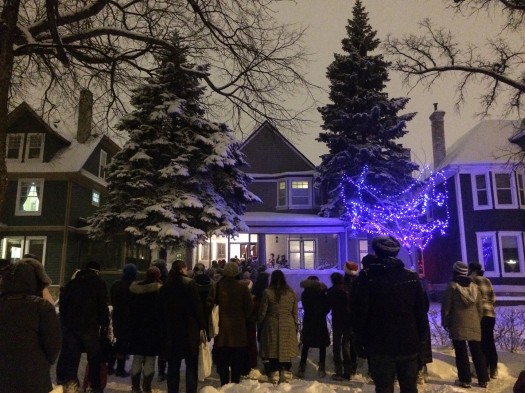
Winnipeg, Manitoba. Copyright: Hazel Borys. Click for larger image.
Shelter from the wind with short blocks. This sense of enclosure is even more important in the winter, which coupled with short blocks helps create shelter from the wind. The way that the buildings address the street, or the “private frontage,” makes for convivial places to gather and meet. If we can control how the building meets the street and nothing more, we’re far along the placemakers way.
Playborhoods and play sheds. Just as it should be a 5-minute walk to most daily needs, it should be a 2.5-minute walk to the nearest place to play. The 5-minute walk is the “pedestrian shed” and the 2.5-minute walk is the “play shed.” Having these neutral gathering places where people of all ages can go to play in parks, playgrounds, and plazas in the winter makes us more likely to enjoy frequent sledding, skating, skiing or just walking. And makes it easier to create a playborhood for free range kids instead of leaving the last child in the woods. When the parks are so close, it’s like skipping stones through the neighbourhood to make places where we have access to nature within the city, which has been shown to reduce our blood pressure, obesity, attention disorders, and depression, as well as increase our mental acuity. This regular activity quickly becomes habit-forming, if it’s easily accessible with these neighbourhood-scale civic amenities.
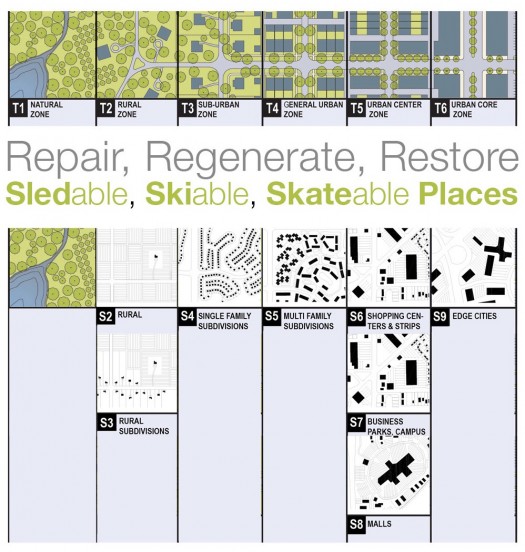
Sprawl Repair Transect. Image credit: DPZ, modified by PlaceMakers.
Legalizing walkable winter cities. Legalizing the useful walk, outdoor rooms, short blocks, and play sheds are the first steps toward a walkable winter city, as well as allowing us to live in season year round. These urban forms are available only by negotiation and not by right for most of North America. Here are a set of blogs about places that are making them legal again with form-based codes and a webinar that includes some of the economic benefits of walkable winter cities.
While Canadian cities offer up so many great ideas about embracing winter, last week’s Maclean’s headlined, “We’ve become a nation of winter wusses.” This extensive piece has many inescapable points about how Canadians avoid the outdoors in winter, where in the past we used to pride ourselves on being the land of ice and snow. I think this shift is due mainly to recent suburban growth patterns.
Queen’s University’s Professor David Gordon’s study, Canada: A Country of Suburbs, finds two-thirds of Canadians live in the suburbs. It is in these inherently un-walkable areas that the country’s fastest growth is happening. No wonder we’re less active in the winter than our grandparents were! Only those of us lucky enough to live in Gordon’s defined “active core” enjoy the sort of urban form that form-based codes or form-based development bylaws deliver. Everywhere else, we just may have legislated snowbirding.
Edmonton’s WinterCity Strategy to transform into a world-leading winter city goes a long way toward creating policies that enable winter livability with thoughtful and playful implementation. I’m happy to see a winter design action item to understand the importance and benefits of compact design, and I hope that makes it all the way to the land use bylaw. In the mean time, I am inspired by the Freezeway, the first 400 metres of which opened a couple weeks ago, which plans on 3.5 km of multi-use track that will be an ice rink in the winter and cycle track in the summer. Looks like an excellent new street section for a winter city form-based code!
If PlaceShakers is our soapbox, our Facebook page is where we step down, grab a drink and enjoy a little conversation. Looking for a heads-up on the latest community-building news and perspective from around the web? Click through and “Like” us and we’ll keep you in the loop.


